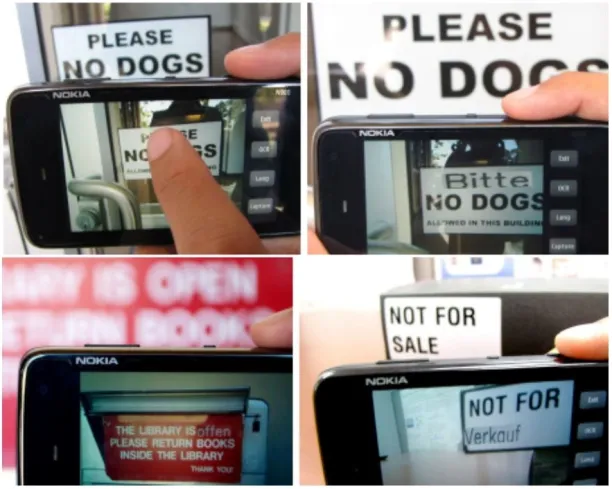Augmented Reality (AR) is a digital media platform that allows the user to integrate virtual context into the physical environment in an interactive, multidimensional way.
Implementing AI enhances the AR experience by allowing deep neural networks to replace traditional computer vision approaches, and add new features such as object detection, text analysis, and scene labeling. We explore AI in AR, its applications, examples, and vendors.
How does AI transform AR?
Historically, AR software used traditional computer vision techniques called Simultaneous Localization and Mapping (SLAM). SLAM algorithms compare visual features between camera frames in order to map and track the environment.
However, modern AR applications rely on deep learning to provide more advanced functionality. AR developers can leverage AI algorithms to offer AR features like enhanced interaction with the surrounding physical environment. AI technologies such as machine learning, GenAI and deep learning are well suited to AR environments because:
- There is an opportunity to collect more data for the AI algorithm to train on since the cameras are always on.
- The input to the AI algorithm is rich in detail because AR environments rely on multiple sensors (e.g. the device’s gyroscopes, sensors, accelerometers and GPS). This provides better reliability than systems relying only on a single sensor.
AI applications in AR
1. Object labeling
Object labeling utilizes machine learning classification models. When a camera frame is run through the model, it matches the image with a pre-defined label in the user’s classification library, and the label overlays the physical object in the AR environment. For example, Volkswagen Mobile Augmented Reality Technical Assistance (MARTA) labels vehicle parts, and provides information about existing problems and instructions on how to fix them.
2. Object detection and recognition
Object detection and recognition utilize convolutional neural network (CNN) algorithms to estimate the position and extent of objects within a scene. After the object is detected, the AR software can render digital objects to overlay the physical one and mediate the interaction between the two. For example, the IKEA Place ARKit application scans the surrounding environment, measures vertical and horizontal planes, estimates depth, and then suggests products that fit the particular space.
For more, feel free to read our image recognition article.
3. Text recognition and translation
Text recognition and translation combine AI Optical Character Recognition (OCR) techniques with text-to-text translation engines such as DeepL. A visual tracker keeps track of the word and allows the translation to overlay the AR environment. Google Translate offers this functionality.

4. Automatic Speech Recognition
Automatic Speech Recognition (ASR) uses neural network audiovisual speech recognition (an algorithm that relies on image processing to extract text). Specific words trigger an image in the library labeled to fit the word description, and the image is projected onto the AR space. An example is the Panda sticker app.
For more, please read our collection of top speech recognition use cases.
5. Environment Mapping and Scene Understanding
Beyond simple object detection, AI enables semantic scene understanding — allowing AR systems to classify entire environments (e.g., kitchen, office, street) and adapt overlays accordingly. Deep learning models like SceneNet or IBM’s Visual Recognition can analyze spatial context, lighting, and surface types to tailor the AR experience.
Example:
Snapdragon Spaces uses AI to detect walls, surfaces, and room types in real time, enabling more realistic placement of virtual furniture or game elements.
Use cases:
- Interior design apps that recommend furniture based on room type
- AR wayfinding that adapts signage to indoor/outdoor environments
- Smart retail that changes promotional content based on store sections
6. Generative AI for Dynamic Content Creation in AR
GenAI models can dynamically generate 3D assets, voices, or even entire scenes based on prompts or user interactions within AR environments. This eliminates the need for preloaded libraries and opens the door to personalized, real-time world-building.
Example:
A marketing app could let users describe their ideal living room, and GenAI would generate furniture and layout in AR.
Relevant models/tools:
- Luma AI (text-to-3D)
- RunwayML for video overlays
- Pika Labs or Spline for real-time 3D modeling
7. Anomaly Detection for Industrial Inspection
AI-enabled AR can help with real-time anomaly detection in manufacturing or fieldwork. Computer vision models trained on what “normal” looks like (e.g., pipe integrity, machine surfaces) can detect deviations and highlight them in the user’s view using AR.
Example:
Porsche uses AR with AI inspection tools to highlight wear, corrosion, or misalignments in auto parts during remote maintenance.
Use cases:
- Maintenance and safety inspections in factories
- Utility infrastructure (e.g. power lines, pipelines)
- Aircraft or vehicle repair assessments
More AI/AR applications in various industries
AR has been used in many applications, especially entertainment and construction. Other industries that can benefit from AI/AR include:
- Construction: Architecture, design, project planning, site revision, safety and inspection, underground constructions, and training.
- Education: Scene expedition (Museum, factory), model experiments in labs (chemistry, physics, geometry, anatomy)
- Entertainment: real time info from sports arenas, augmented music concerts, interactive ads, movies, and games.
- Medicine: diagnosis, surgical navigation, training surgeons on new procedures, and modeling drug effects.
- Logistics: warehouse planning and operations, transportation optimizations, and inventory management
- Manufacturing: design and prototyping, maintenance, repair and training,
- Military: aircraft navigation, weapon aiming, and telepresence in military operations.
- Real estate: Marketing, interior design, floor planning, construction staff training.
- Fashion: try-before-you-buy, in-store navigation, personalized shopping, AR window shopping, and makeup apps.
AI enabled AR Software Vendors
According to Statista, the global market of augmented reality (AR), virtual reality (VR), and mixed reality (MR) is estimated to reach $100B by 2026.2 Companies such as Apple and Google are in the market for developing AI-enabled AR software to enhance customers’ AR experience.
Here are the top AI enabled AR software vendors:
Apple ARKit
ARKit is Apple’s augmented reality (AR) development platform for iOS iPhones and iPads. ARKit provides object labeling, people occlusion, motion capture, and multiple face tracking. ARKit has been used in:
- Education to model practical experiments in science, physics, or chemistry labs, such as Labster
- Construction and architecture to measure spatial dimensions and suggest products or solutions, such as IKEA place.
- Entertainment, such as Pokemon GO.
Google ARCore
ARCore is Google’s AR platform, ARCore integrates digital content into the physical environment via motion capture and object detection and recognition. ARCore has been used in:
- Real estate to visualize, decorate, and design empty spaces. Such as Sotheby’s Curate app
- Lifestyle and maintenance to connect users with professionals who provide guidance and instruction, take measurements, and project potential solutions into the space. For example Streem app.
- Entertainment such as TendAR virtual pet game app.
Others
Other AI/AR software vendors include:
- Amazon Sumerian
- Microsoft Mesh
- Unity
- Vuforia Engine
- Zap Works
External Links
- 1. Fragoso, Victor & Gauglitz, Steffen & Zamora, Shane & Kleban, Jim & Turk, Matthew. (2011) TranslatAR: A mobile augmented reality translator. 2011 IEEE Workshop on Applications of Computer Vision, WACV 2011.
- 2. XR market size worldwide 2023-2028| Statista. Statista


![XR/AR in Manufacturing: 7 Use Cases with Examples [2025]](https://research.aimultiple.com/wp-content/uploads/2023/01/XRAR-in-manufacturing-2-190x107.png.webp)
Comments
Your email address will not be published. All fields are required.